Defending the Mountains
Air Date: Week of April 24, 2009
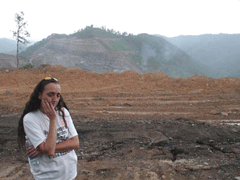
Maria contemplates the ongoing demise of Kayford Mountain, West Virginia. (Photo: Vivian Stockman)
Host Jeff Young visits coal country activist Maria Gunnoe, who's fighting to stop the mining practice known as mountaintop removal. Gunnoe just won the prestigious Goldman Prize, sometimes called the Green Nobel. But she fears she's losing the mountains, community and heritage she holds dear.
Transcript
YOUNG: It’s Living on Earth, I’m Jeff Young.
Each year the prestigious Goldman Environmental Prize, sometimes called the "Green Nobel," goes to just six people on this planet: one on each inhabited continent. They're singled out for taking a stand and making a difference on major environmental threats.
This year-- the 20th year for the Goldman prize--the North American winner is Maria Gunnoe, from the heart of coal mining country in West Virginia. Gunnoe's fighting to stop the mining practice known as mountain top removal, even as she and her family cope with life next to one of the giant coal operations.
[TRAIN CROSSING HIGHWAY] YOUNG: Gunnoe lives in Boone County, West Virginia, where coal trains and narrow roads twist through sharp valleys. Modest homes compete for the few flat patches along the road, rails and river. And most of the hills bear the marks of the region's main industry: coal.
GUNNOE: You can look to the east, west, and to the south of my house and you have mountain top removal sites. In just about every direction I look from my home that’s what I see now. YOUNG: Gunnoe's a 40-year-old mother of two. She's lean and angular with long, dark hair and a tomboy's gait. In a light April rain, she shows me around the land where her family has lived for generations.
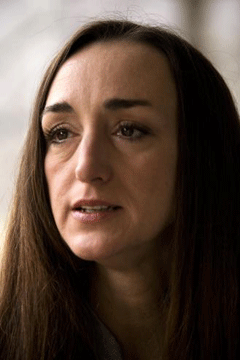
Maria Gunnoe (Photo: Antrim Caskey, Courtesy of Goldman Environmental Prize)
GUNNOE: My father and my grandfather prepared this place throughout the years to sustain us, to feed us basically. There’s black walnut here, white walnut. We have peach trees. This used to be an orchard until the flood took place and it tore a lot of trees out of the ground.
[SOUND OF STREAM]
YOUNG: The flood was a watershed event in her life. In 2003 this small stream on her property became a rushing torrent, filing the hollow from hillside to hillside.
GUNNOE: There was acres of my land that washed by me and my family while we sat on our front porch. I mean, it was terrifying, it really was.
YOUNG: Of course, floods happen in this part of the country – you’ve got steep hills and you get quite a bit of rain. But you don't think this was just a natural flood?
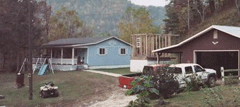
Before the flooding. (Courtesy of Maria Gunnoe)
GUNNOE: No I absolutely don’t. This wasn’t a natural flood – it was a manmade flood. What happened in 2000, there was a mountain top removal site moved into my backyard. And they ripped off about 400 ft of peak of the mountain that was adjacent to my property. They took the trees off and they took bulldozers and pushed what they call the overburden over into the valley behind me and created a valley fill. And when they started blasting, they put everything other than the coal into this valley fill. And just through the manipulation of the headwaters of this stream, what it’s done is created sort of like a paved parking lot, if you will. It's nothing but rock in the valley behind me, now, where it used to be mountains.
YOUNG: Across coal country residents say the flash flooding after mountain top removal was far worse than anything in memory.

After the flooding. (Courtesy of Maria Gunnoe)
Gunnoe decided to fight back by organizing. She works with local groups to press government officials for better regulation and enforcement. She's joined numerous lawsuits against coal companies, even in the face of harassment and intimidation. And she helps neighbors keep track of the mining and its damages.
[SOUND OF TRUCK DOOR OPENING]
YOUNG: We climb into Gunnoe's pickup for a driving tour of a nearby community called Twilight.
[TRUCK SOUNDS]
GUNNOE: In November of last year I sat and watched the sunset on that mountain for the last time ever. It'll never happen again. Now the mountain has been blasted away, it's been pushed into the valley.
YOUNG: A federal government assessment estimates more than a thousand miles of streams in Appalachia have been buried or polluted by valley fills. And some 800 square miles of mountaintop are now gone. Gunnoe fears the community here could soon be gone, too.

Maria contemplates the ongoing demise of Kayford Mountain, West Virginia. (Photo: Vivian Stockman)
[TRUCK DOOR OPENS, DOG BARKS, DOOR SHUTS]
YOUNG: We stop for a visit with Lora Webb, who lives with her husband and daughter just a few hundred yards from the entrance to a mountaintop removal site. Others around her are already moving, either lured by buyout offers from the coal company or just tired of the noise and dust from blasting and massive earth moving equipment. Webb wants to stay. But she's not sure she can if it means living next to the mine.
WEBB: Well, I've got bad neighbors [Laughs]. They do a lot of things that wouldn't be put up with anywhere else. From a regular person’s viewpoint, you can’t really see the extent of the damage, unless you’re in the air, and then it looks like Hiroshima, like a bomb went off.
YOUNG: What do you think's going to happen here? What do you think is gonna happen to your place and what do you think is going to happen to this whole community, Twilight?
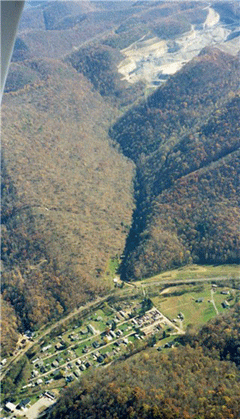
(Courtesy of Maria Gunnoe)
WEBB: I think if king coal has his way about it, I think it'll be gone, it won't exist anymore. You know, what kind of treatment is that to citizens of a community that's supplying the rest of America with power? And nobody to help em. What are they gonna do? They're gonna lose everything they've got - that's what’s gonna happen. That’s what I feel like is happening to us right now. Like it's just sand running through your fingers [Cries]. [
DOOR OPENS]
GUNNOE AND WEBB: Ok, be good. Thanks, see ya.
[TRUCK SOUNDS]
GUNNOE: It's a hell of a way to live.
YOUNG: Back in the truck, Gunnoe points out other homes where people have sold or just moved on. This community's name has never been more apt: it is in the twilight of existence.
GUNNOE: It's honestly some of the most giving, loving people you will ever meet in your life. And if you'll look, the houses are being torn down.
YOUNG: Oh yeah that's gutted out
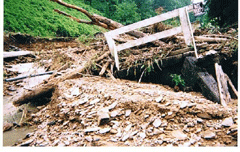
(Courtesy of Maria Gunnoe)
GUNNOE: That's the home of one of the elders that recently passed away. The coal company got what they wanted.
YOUNG: Here's another one.
GUNNOE: Yeah, the houses are being demolished. The coal companies have no uses for those houses. They don't intend for on people being here.
[YARD AMBIENT SOUND]
YOUNG: More than a decade of lobbying and lawsuits, demonstrations and protests have not slowed mountaintop removal. But recent action by the Obama administration could signal a change.
The Environmental Protection Agency is now reviewing mining permits focusing on the valley fills and their effects on water quality. It's not yet clear what the review will mean. But for Gunnoe, it seems like a lifeline of hope. Some of the permits under review are for mines on hills surrounding her house.
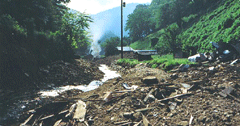
(Courtesy of Maria Gunnoe)
GUNNOE: With the new administration I have a sense of hope that I have not had in many years here. And it's because of the fact that we’re being heard in DC. I think we’ve cried loud enough and long enough that we should have been heard long ago. Now there's someone in office who cares about people. I really believe it's going to change.
YOUNG: Do you get sense it’s now or never?
GUNNOE: Absolutely I do. In some cases, for some communities, it’s already too late. But there’s other communities that’s just barely hanging on. And the decisions being made in Washington DC seals the fate of those communities.
YOUNG: With all that's going on, is it worth it to stay here?
GUNNOE: Absolutely. This is where I belong, this is where our memories lay at, this is
where my family lays for God's sake. I'm not leaving. I'm here for the long haul and I will stand here as evidence of what these coal industry’s put these people through. This is where I live, this is where I die, this is where I'll be after I'm dead and gone.
YOUNG: Maria Gunnoe, winner of the 2009 Goldman Environmental Prize.
Links
More about Maria Gunnoe and the group she works with, Ohio Valley Environmental Coalition
EPA's environmental assessment of mountaintop removal
Discussion of the Obama administration's recent action on mining permits
Living on Earth wants to hear from you!
Living on Earth
62 Calef Highway, Suite 212
Lee, NH 03861
Telephone: 617-287-4121
E-mail: comments@loe.org
Newsletter [Click here]
Donate to Living on Earth!
Living on Earth is an independent media program and relies entirely on contributions from listeners and institutions supporting public service. Please donate now to preserve an independent environmental voice.
NewsletterLiving on Earth offers a weekly delivery of the show's rundown to your mailbox. Sign up for our newsletter today!
 Sailors For The Sea: Be the change you want to sea.
Sailors For The Sea: Be the change you want to sea.
 The Grantham Foundation for the Protection of the Environment: Committed to protecting and improving the health of the global environment.
The Grantham Foundation for the Protection of the Environment: Committed to protecting and improving the health of the global environment.
 Contribute to Living on Earth and receive, as our gift to you, an archival print of one of Mark Seth Lender's extraordinary wildlife photographs. Follow the link to see Mark's current collection of photographs.
Contribute to Living on Earth and receive, as our gift to you, an archival print of one of Mark Seth Lender's extraordinary wildlife photographs. Follow the link to see Mark's current collection of photographs.
 Buy a signed copy of Mark Seth Lender's book Smeagull the Seagull & support Living on Earth
Buy a signed copy of Mark Seth Lender's book Smeagull the Seagull & support Living on Earth

